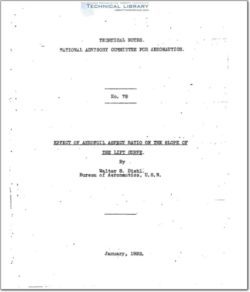naca-tn-79

- Version
- 200 Downloads
- 388.35 KB File Size
- 1 File Count
- April 19, 2016 Create Date
- April 19, 2016 Last Updated
National Advisory Committee for Aeronautics, Technical Notes - Effect of Aerofoil Aspect Ratio on the Slope of the Lift Curve

The speed, barometric pressure, and number of revolutions of
the engine of a seaplane were measured, including tests with
stopped engine. The mean data obtained are given in the following .
note; the results of the gliding tests are used for the computa—
tion of the lift and drag coefficients, and by making use of them
the results of the engine flights are used for the computation of
the propeller efficiency.
The free flight tests described in this note were made by the
author and Dr. Erich Hueckel at the testing station at Warnemuende
during the summer of 1918, and are here published for the first
time. It was intended to develop a simple method for the examina—
tion of the aerodynamical properties of a seaplane independent of
the characteristics of its propeller. The instruments had to be
simple and self-recording, and no long preparation of the air-
plane for the test could be allowed. On the contrary,-the instru-
ments had to be mounted in the airplane only a short time before
the beginning of the test. The method was used with one airplane
only, and the opportunity was taken to determine its lift and drag
coefficients and the propeller efficiency.
The instruments used for the tests were a chronograph and an
ordinary barograph. The first instrument was similar to a.Morse
telegraph receiver; a paper strip about 1%" broad, moved with a
velocity of about 7“ per minute under four needles, which when unr
der the influence of four independent electromagnets, marked the
paper without stopping its course. The needles were controlled
respectively by an ordinary clockwork, by the flexible shaft of
the revolution counter of the engine, by an anemometer of the Bob-
inson type and by hand. The clock gave electrical contacts at in-
tervals of 13 seconds, the shaft leading to the revolution counter
always after 26 revolutions of the shaft, corresponding to 52 rev-
olutions of the engine. The anemometer gave contact after each
180 feet of travel of the-airplane approximately.
| File | Action |
|---|---|
| naca-tn-79 Effect of Aerofoil Aspect Ratio on the Slope of the Lift Curve.pdf | Download |

Comment On This Post